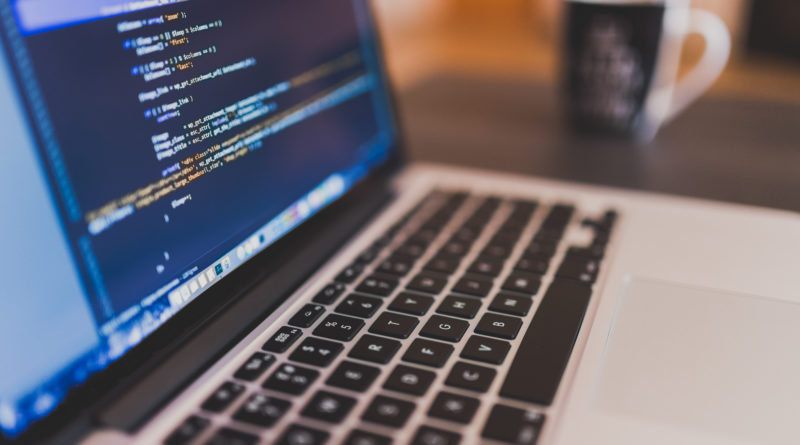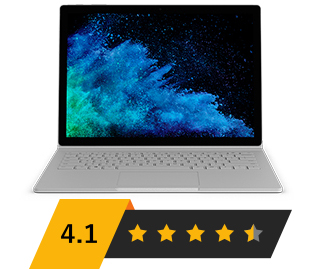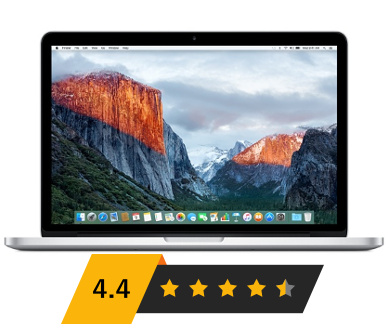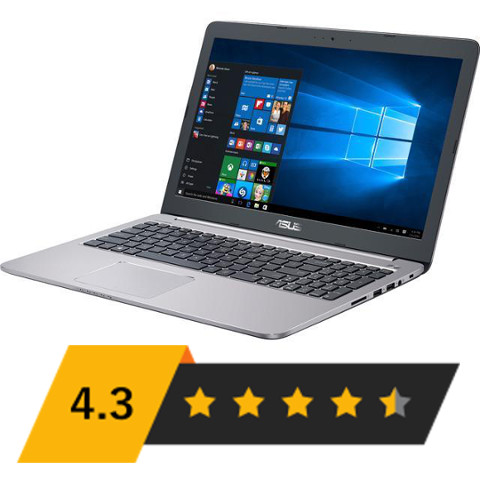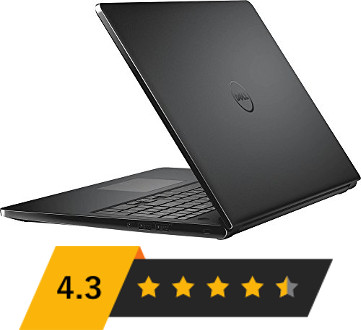The Best Computer For Programming
Table of Contents:
- Introduction
- Computer/Laptop Options
- HP 15-AY013NR
- Microsoft Surface Book 2
- Apple MacBook Pro
- Asus K501UW-AB78
- Dell Inspiron Flagship Touchscreen
- Infographic / Buyers Tips
- Conclusion and Comments
Introduction:
Finding a decent computer for anything can be difficult.
Let alone finding the best computer for programming.
The following reviews focus on aspects that are the most important when buying a computer or laptop for programming. We’re going to look over the main aspects and compare, then offer individual details about each computer/laptop.
What is the Best Computer for Programming?
First, what are we looking for when buying a laptop or computer for programming? The majority of computers have the necessary specifications for any software or IDE’s you’ll need. So what else should we look at?
Well it depends a lot on the purpose and if you are looking for absolute optimization for whatever IDE/language you’re using. Also, you have to focus on the human aspects and interaction. Is the keyboard compact and easy to use? Is the display large enough to not have to zoom in to see what you typed? Maybe even portability if you’re looking for a laptop?
A major issue is that there are hundreds of different laptops to choose from, and although many of them will allow you to code, they might not be the best options for your needs.
The following list of specs are what we looked for in our reviews:
- Screen size
- Hard Drive
- RAM
- CPU
- Battery Life
- MAC or Windows?
- Budget
Programming Computer Comparison Table
| Computer | HP 15-AY013NR | Microsoft Surface Book 2 | Apple MacBook Pro | Asus K501UW-AB78 | Dell Inspiron 15 |
| Screen Size | 15.6″ | 13.5″ | 13.3″ | 15.6″ | 15.6″ |
| Hard Drive | 128GB | 256GB | 128GB | 512GB | 256GB |
| RAM | 8GB | 8GB | 8GB | 8GB | 16GB |
| CPU | 2.3 GHz Intel Core i5 | 3.5 GHz Intel Core i5 | 2.7 GHz dual-core Intel i5 | 2.5 GHz Intel Core i7 | 2.5 GHz Intel Core i7 |
| Battery Life | 7.15 hrs | Up to 17 hrs | Up to 9 hrs | 7 hrs | 5 hrs |
| OS | Windows 10 | Windows 10 Pro | MAC OS X | Windows 10 | Windows 10 |
| Budget | $400-$550 | $1,400 | $700-$800 | $700-$800 | $600-$750 |
| Check Prices | Prices | Prices | Prices | Prices | Prices |
Now to take a look at each individual laptop, it’s pros and cons, and if it’s the right computer for a programmer.
HP 15 AY013NR – An Affordable Programming Laptop
HP is a reliable brand and has many products. Ranging from computers to printers.
The HP laptop we reviewed offers a 15.6 inch Full-HD display and comes with SVA anti-glare tech. However, it’s storage is a little lower than most, at 128 GB SSD (or 1TB of hard disk), but it does compensate with a little more speed.
The laptop clocks in at a good 2.3GHz and with an 8GB RAM-DDR3L SDRAM. So if you’re looking for a multi-tasking laptop that’s multi-purpose, this is a decent choice.
It comes with Windows 10 and the usual list of necessary ports, such as an RJ-45, HDMI, USB 3.0 and 2.0, Headphone/mic jack, optical drive, and media reader.
- Budget friendly
- Larger screen size
- Good battery life
- 128GB SSD
- Keyboard has no backlight
HP 15 AY013NR
Microsoft Surface Book 2 – The Best Portable Laptop
Microsoft has made some quality products in the past and continues to do so now.
The Surface Book is great for small gaming purposes, programming, illustration, and general everyday computer usage. It’s obviously portable with an impressive 13.5-inch screen, meaning a Netflix binge is just another task to add to the list.
Impressively, the Surface comes with a pretty long battery life, an average 8GB of RAM, and a very pleasing design. But good performance and design have been pretty common with Microsoft.
- Incredible battery life
- Great screen resolution
- Fast and powerful
- Pricey
- No Surface Pen included
Microsoft Surface Book 2
Apple MF839LL/A MacBook Pro
If you’ve been looking for a new laptop, then you’ve undoubtedly come across the MacBook options available..
The popularity across different groups and hobbyists demonstrates the MacBook Pro’s diverse use cases.
But what does the MacBook come with?
The Apple MacBook Pro 13-inch MF839LL/A comes with an LCD resolution of 2560 x 1600, 8GB of memory, and a slightly low 128GB hard drive. You’ll probably want more storage space and thankfully there are upgraded versions that range up to 512GB.
Its processor is an Intel Core i5 at 2.7GHz and has a Intel Iris Graphics 6100 video adapter but no dedicated graphics memory. Also, it doesn’t have a CD drive for burning or reading discs sadly. Although, an important upside is that the Macbook pro is backed by a 12 month warranty, with 3 months of tech support.
- Sleek design
- Long lasting battery
- Great performance
- No DVD/CD disc reader
- Low storage on base model
Apple MF839LL/A MacBook Pro
Asus K501UW-AB78 – Normally A Gaming Laptop
The K501UW has been heavily pushed as a gaming laptop and it’s easy to see why.
It has all of the features you’d expect from a top notch gaming laptop, including a NVIDIA GeForce GTX 960M graphics card. That being said, don’t take it off your list if you want a high performance laptop for other uses.
It has an average 8GB of memory, a 512 solid-state-drive (SSD), a 15.6-inch Full HD display, and a backlit keyboard. Add in its Intel Core i7-6500U processor and NVIDIA graphics card, and you have a laptop that is perfect for performance gaming or programming.
This gaming laptop also comes with two dedicated fans, one for it’s CPU and another for the GPU. To save space and efficiency, the processors share the same heat sink and will cool the machine down during exhaustive computing.
An extra note to make is that the 8GB of memory is the baseline, but expansion is available through a SO-DIMM socket. So if you’d prefer more speed, there is the option to add more.
- More than average base storage space
- 1 year Accidental Damage Protection by Asus
- Combination of RAM and NVIDIA graphics card
- Expanable RAM slots
- Not much
Asus K501UW-AB78
Dell Inspiron Flagship Touchscreen
The Dell 15.6 inch flagship touchscreen is an affordable laptop that fits a variety of purposes that require speed and comfort.
The Inspiron 15 comes with touchscreen capabilities (obviously), a 15.6 inch display, and a max resolution of 1366 x 768 pixels. It has a bit more weight to it due to it’s size, but that can be expected. If you’re looking for something large and light, it won’t be an easy search.
Regarding performance, it also comes with a good amount of speed for the price. The Inspiron 15 comes with a 7th Gen Intel Core i5-7200U mobile processor and 16GB of RAM. While it’s clearly not a super computer, it does have a perfect combination suited for multi-tasking and running multiple programs at once.
The laptop also comes with 256GB of Solid State Drive storage. For most people, 256GB is more than enough storage. However, if you’re looking for more storage, there are similar models of the Dell 15 that go up to 1TB.
- 16GB of RAM/fast processing
- Great price for speed
- Touchscreen
- Large laptop (may not be a problem for some)
Dell Inspiron Flagship Touchscreen
Buyers Infographic Tips
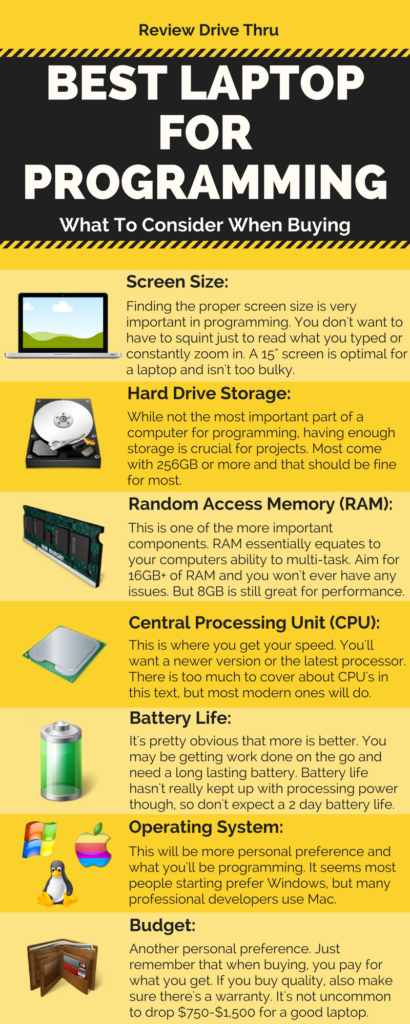
Share this Image On Your Site
Conclusion
The suggestions above for a programming laptop were picked because of their performance and reliability. If they aren’t what you’re looking for, just remember that you’ll need the above criteria to really judge a good laptop or computer. We suggested laptops since most programmers starting out prefer portability. But the same principles for finding a computer apply. Best of luck picking the right computer/laptop for you!
